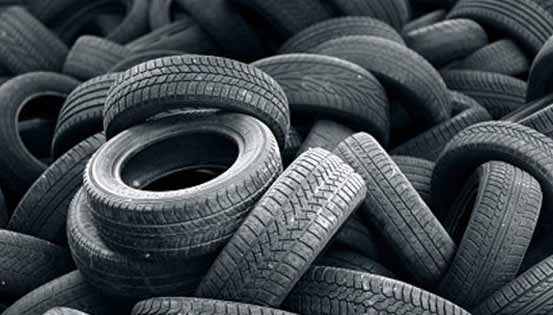Though Natural rubber has been available since time immemorial, Synthetic Rubber has come of use for less than a hundred years. Synthetic rubber plants were built around the world after 1945, primarily in North America, Japan and Europe. In 1960, use of synthetic rubber was more than that of natural rubber for the first time. Synthetic rubber has maintained this lead since then. As per a report published in 2001, the world makes around 11.5 million tonnes of synthetic rubber each year. USA is the largest producer of synthetic rubber by far, followed by China, the EU and Japan.
What is Synthetic Rubber?
Rubber is a collective term for macromolecular substances of natural origin known as natural rubber (NR) or synthetic origin or manmade known as synthetic rubber (SR). Synthetic rubber is one of the types of rubber. It is a white, crumbly, plastic mass which is processed and vulcanized in the same manner as natural rubber. In other words, synthetic rubber is an artificially produced material having properties similar to natural rubber. Most synthetic rubbers are obtained by polymerization or polycondensation of unsaturated monomers. There are wide varieties of different synthetic rubbers, reflecting the various different applications and the chemical and mechanical properties they have. Co-polymerization of different monomers leads to the material properties of synthetic rubber to be varied across a wide range.
Check out Types of Synthetic Rubber to get a better idea on the different types of synthetic rubber that are being produced world wide by using different chemicals and minerals. Each synthetic rubber has its own individual properties, advantages and diasadvantages.
Factors Leading to Synthetic Rubber Production
Though, World war II became the force for the emergence of synthetic rubber on a large-scale basis when governments began building plants to balance natural rubber shortages, there were other various reasons as well after the war which led to the development of an alternative or substitute for natural rubber. Some important factors resulting to the production of synthetic rubber are
- Rising prices for natural rubber on the world market in response to the general state of the economy
- Political events which cut customers off from the suppliers of raw materials
- Long transport distances
- Regional constraints with respect to establishing rubber plantations
- The increase in global demand for rubber.
Production Process of Synthetic Rubber
Synthetic rubber can be produced in different ways. One common process adopted by synthetic rubber manufacturers is shown below:

Applications of Synthetic Rubber
Synthetic Rubber Usage Like natural rubber, synthetic rubber has a varied range of applications, such as follows:- Tire industry (car, aircraft and bicycle tires)
- Drive belts
- Hoses
- Medical equipment
- Seals
- Floor coverings
- Conveyor belts
- Molded parts etc.
Properties of Synthetic Rubber
There are different varieties of synthetic rubber, each having their unique properties. Some of the common properties of synthetic rubber are as follows:
- Better abrasion resistance
- Good Elasticity
- Better heat and aging resistance
- Electrical insulation material
- Flexible at low temperatures
- Flame retardant
- Resistant to grease& oil etc.
Related Articles
- Anti Vibration Mountings
- Automobile Rubber Products
- Calendered Rubber Products
- Extruded Rubber Products
- Medical Rubber Products
- Metal Bonded Components
- Rubber Adhesives & Sealants
- Rubber Ball
- Rubber Bands
- Rubber Beading
- Rubber Bearing
- Rubber Belt
- Rubber Buckets
- Rubber Bullets
- Rubber Cable
- Rubber Coating
- Rubber Duct
- Rubber Expansion Joints
- Rubber Flooring/Matting
- Rubber Footwear
- Rubber Gloves
- Rubber Injection Parts
- Rubber Lining
- Rubber Magnets
- Rubber Molded Products
- Rubber Pads
- Rubber Rollers
- Rubber Stopper
- Rubber Suit
- Rubber Track
- Rubber Valve
- Rubber Balloon
- Rubber Stamps
- Rubber Fenders
- Acrylic Rubber (ACM)
- Butadiene Rubber (BR)
- Butyl Rubber (IIR)
- Chlorosulfonated Polyethylene(CSM)/ Hypalon
- Ethylene Propylene Diene Monomer
- Fluoroelastomers (FKM)/Viton
- Isoprene Rubber (IR)
- Nitrile Rubber (NBR)
- Perfluoroelastomer (FFKM)
- Polychloroprene (CR)/Neoprene
- Polysulfide Rubber (PSR)
- Silicone Rubber (SiR)
- Styrene Butadiene Rubber
How to Make a Custom Rubber Stamp?
Whenever designing a custom stamp for your company, never compromise on its quality because in the end it is the most...
Read MoreLatex and Silicone Rubber Tubing - A Comparison!
Many industries use rubber tubing for various purposes. In fact, various types of rubber tubing are used for different applications...
Read MoreSilicone vs Acrylic Adhesive- A Comparison
Silicon and acrylic adhesives are those rubber adhesives that are widely used in Polyimide tapes. In fact, the polyimide...
Read More

